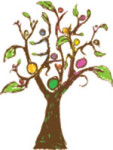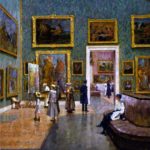A Prototype Learning Tool
 This site’s in-progress gallery of innovation examples, combined with a “lens” for viewing the examples, represents a sample learning tool that is made possible by a framework of innovation’s essential forces, or underlying principles:
This site’s in-progress gallery of innovation examples, combined with a “lens” for viewing the examples, represents a sample learning tool that is made possible by a framework of innovation’s essential forces, or underlying principles:
- The lens is to represent the framework of forces/principles (a potential public good).
- In combination with widely-varying examples of innovation, the lens is to support seeing: (i) the examples all as variations on the same driving forces; and (ii) just how varied examples are.
- Ultimately, this type of lens is to support young people in seeing the world differently, including seeing new possibilities for themselves — for making compelling personalized connections with purposes in the larger world, as well as seeing the essential means for making a difference.
- It’s to help cultivate the win-win of more engaged work lives for individuals and more societal-level impact.
- Innovation’s methods call for the personalized connection and support capability for generating impact.
From cognitive science: “The surest way to help students understand an abstraction is to expose them to many different versions of the abstraction.”
And from the Kauffman Foundation:
“Human beings can observe and/or be shown how the activities of humanity have changed the environment, fostering the realization that other people may be able to also bring about change. … A sense of what has been done helps lead to a sense of what might be done, as well as an appreciation for the kinds of established constraints that might affect imagined changes.”
Part of a Larger Idea —
 This prototype leaning tool fits into an overall hypothesis regarding the potential multi-faceted learning power of the type of framework represented by this site’s lens, again as a public good. A separate web site, IngenuityEpoch.org, elaborates the hypothesis and its connection of knowledge sources.
This prototype leaning tool fits into an overall hypothesis regarding the potential multi-faceted learning power of the type of framework represented by this site’s lens, again as a public good. A separate web site, IngenuityEpoch.org, elaborates the hypothesis and its connection of knowledge sources.
- That site also includes sketches of sample learning applications of the framework.
- One of the sketches is the basis for this site’s prototype gallery of innovation examples (or “profiles”).
- The sketch assumes a profile template that reflects innovation’s constant forces, with tags that highlight innovation’s many elements of variation.
- The in-progress prototype at this site represents a very early and rudimentary beginning (including increasing approximation of a design for the profile template).
The following excerpt from the application sketch at IngenuityEpoch.org speaks to the much more ambitious possibility envisioned:
An Ongoing World’s Fair of Innovation —
 The ideal experience of visiting an eventual online gallery of innovation profiles might be like visiting a hands-on world’s fair or museum or trade-show:
The ideal experience of visiting an eventual online gallery of innovation profiles might be like visiting a hands-on world’s fair or museum or trade-show:
Wings and special exhibits could be curator-determined, but also interactive, such that visitors could customize, archive, tag, and share their own collections. Visitors also could receive notices of (or search for) new profiles.
A wing’s cluster of profiles might reflect any combination of the constants and variables. For example, curated wings might feature profiles of offerings that are:
- world changing
- based on new technology
- based on appropriate technology
- based on ordinary knowledge
- illuminating of innovation’s “social differential,” including catalysts for change in customers’ behavior and capability
- growing out of startup organizations versus other types of organizations
- contributing to sustainable development
- within ventures seeking a triple bottom line
- based on seizing opportunity versus addressing a problem
- illustrating increasing complexity, from an effective new connection of simple knowledge to a connection of a complex web of knowledge
- and so on.
Since visitors to this online gallery could go from one wing to another within a second or two, rather than walking long distances, there could be a large number of wings. Also, a visitor could arrange a wing’s profiles according to personal preferences and could create, save, and share their own wings.
The possibilities for clustering are limited only by tags. In addition to variables such as those above, tags might highlight offerings that are:
- co-created with customers
- based on public-private partnerships
- benefiting a certain category of customer (retirees, teens, women, children, etc.)
- originally conceived of as new value with subsequent need to figure out a source of revenue
- enacted within public service agencies
- featuring disruptive innovation for any sector
- enacted by youth
- catalyzing change in customers’ behavior or capability, arranged by difficulty of change and learning
- led by a woman
- featuring a like-business-model (e.g., matchmaking of any type)
- filling a gap in the marketplace
- and so on.
The fair (or museum or trade show) also could offer learning tools beyond its collection of profiles. It could include resources for educators (e.g., practice topics for youth), links to related resources such as Open IDEO and much more.
Subscribe to “Offering of the Day” —
The gallery could deliver an “offering of the day (or week)” delivered via email or social media (and perhaps featured independently in news media as “good” news). Subscribers could opt for particular industries for their offering of the day, with everyone receiving one universal selection. The latter is to support intelligibility of innovation’s constants across industries and more, including supporting cross-pollination.
Essentially, an offering of the day is to put innovation’s concrete purpose and practice into public drinking water, to stimulate conversations and questions. The offerings should be clear enough for middle school students.
The sketch continues at IngenuityEpoch.org, including speaking to “how” it might come about.
I welcome all comments on the overall hypothesis, this site, etc.
Thank you for visiting.
Karen Gates
kgates@umich.edu
